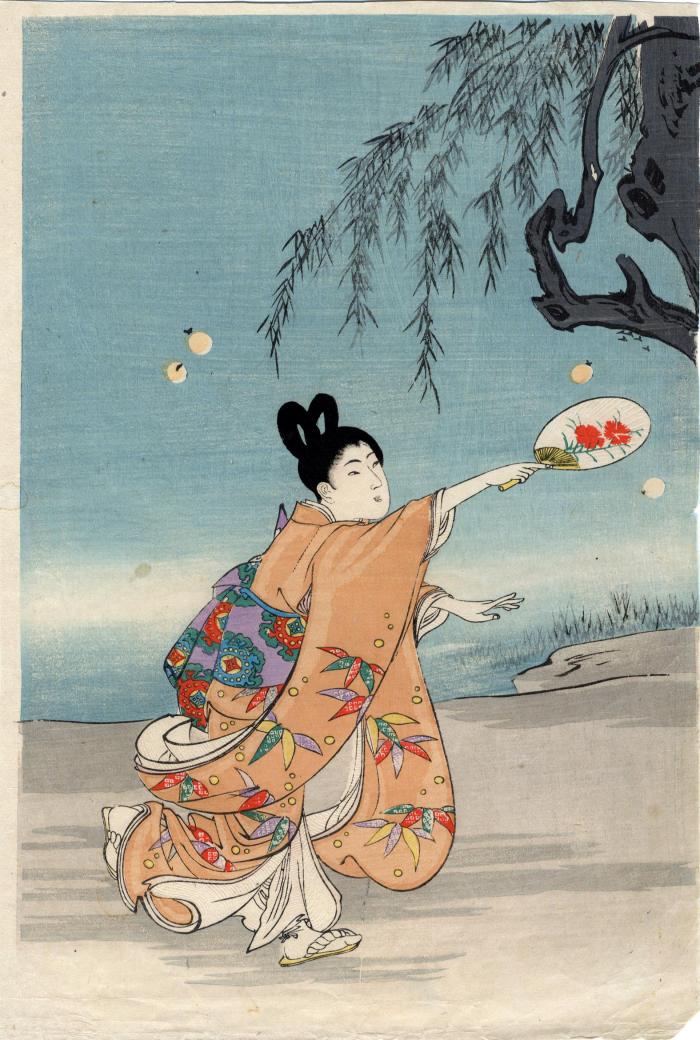Toyohara Chikanobu (豊原周延) (artist 1838 – 1912)
Fireflies (hotaru - ほたる) from the series The Inner Precincts at Chiyoda (Chiyoda no Ōoku - 千代田之大奥)
05/1896
9.75 in x 14.25 in (Overall dimensions) Japanese woodblock print
British Musuem - the full triptych
National Diet Library - the full triptych
Tokyo Metropolitan Library - the full triptych
Metropolitan Museum of Art - the whole triptych
Google map - Chiyoda, Tokyo
Ishikawa Prefectural Museum of Art - the full triptych The Chiyoda Palace was first the residence of the shogun, but became the home of the Emperor and his family in 1868. The British Museum wrote online of this triptych: "Young woman of samurai rank (seated centre) on a nighttime excursion to view summer fireflies, with lady-in-waiting holding a lantern (perhaps filled with fireflies), and young maid chasing fireflies with a fan."
****
The publisher's seal which appears on the far right panel in the triptych shown below appears to be that of Fukuda Kumajirō (Marks 071 - seal 30-046). David Diez Galindo identifies the publisher as Fukuda Hatsujirō. He identifies the carver as Tsuge tō 柘植方. The signature is Yōshū Chikanobu (楊洲周延) .
****
"The spatial layout of Chiyoda castle reflected the principles of concealment that buttressed the shogun's authority. Closest to the main entrance was the largest reception hall, the ōhiroma 大広間 shaped like a squared U. The left side contained three rooms called dan 段, each elevated above the other. The shogun usually sat in the upper dan. At the bottom of the U and up its right side were the second, third, and fourth reception rooms called ma 間... Since the ōhiroma was the farthest from the interior, it was reserved for the most powerful tozama daimyo and the most formal of ceremonies. Farther in the interior was the Shiroshoin 白書院 that had two reception rooms, the upper and lower dan as well as two waiting rooms. It was for fudai daimyo and the shogun's relatives. Deeper yet was the Kuroshoin 黒書院 for the shogun's officials, considered to be more a part of his family than his relatives... It also constituted the setting for smaller, informal interactions between the chief daimyo and the shogun... The shogun's private quarters lay beyond that. Deep within castle walls was the Great Interior (Ōoku 大奥) for the shogun's women, officially off-limits to all men except the shogun. Unlike the vistas, public gardens, and plazas that distinguished Versailles, the Chinese Forbidden City, or the Ottoman sultan's Topkapi palace, the maze of rooms and corridors in Chiyoda palace was designed to confuse the unwary and conceal the shogun's whereabouts from potential enemies."
Quoted from: The Culture of Secrecy in Japanese Religion.
****
There is a copy of the full triptych in the Museo de Valladolid.
****
Illustrated in color in a doctoral thesis 'La Colección de grabados ukiyo-e de los artistas Toyohara Kunichika y Yōshū Chikanobu en el Museo Oriental de Valladolid' by David Diez Galindo, Universidad Zaragoza, 2022, page 348 (The whole triptych is shown.).
Fukuda Kumajirō (福田熊次郎) (publisher)
beautiful woman picture (bijin-ga - 美人画) (genre)
Meiji era (明治時代: 1868-1912) (genre)
